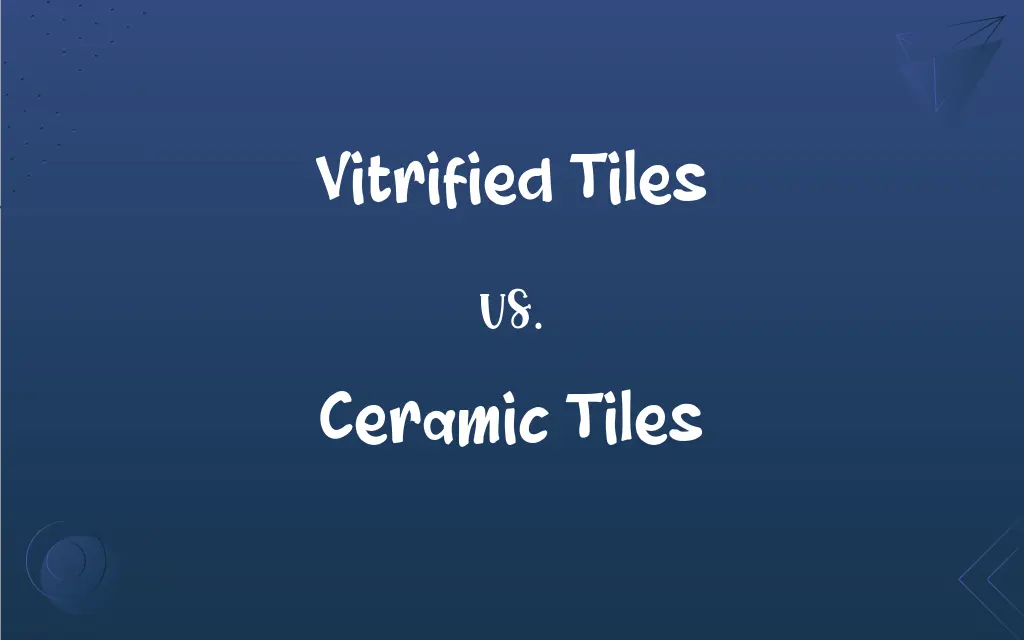Vitrified Tiles vs. Ceramic Tiles: What's the Difference?
Edited by Aimie Carlson || By Harlon Moss || Updated on October 25, 2023
Vitrified tiles are highly durable and less porous compared to ceramic tiles, which are made from natural clay and are more prone to moisture.

Key Differences
Vitrified tiles are made by combining clay with feldspar, quartz, and silica under high temperatures, resulting in a glass-like texture. Ceramic tiles, on the other hand, are simply baked clay, resulting in a porous surface.
Vitrified tiles are known for their durability and stain-resistance, due to the vitrification process. Ceramic tiles, while versatile and cost-effective, are more susceptible to wear and staining.
Vitrified tiles often come in a larger variety of finishes, from matte to glossy. Ceramic tiles typically have a matte finish but can also come glazed for a shinier appearance.
When considering water absorption, vitrified tiles stand out as they absorb less water compared to ceramic tiles, making them more suitable for moisture-prone areas.
Comparison Chart
Composition
Combination of clay, feldspar, quartz, and silica.
Made from natural clay.
ADVERTISEMENT
Finish
Range from matte to glossy.
Typically matte or glazed.
Durability
Highly durable and stain-resistant.
Less durable and more susceptible to staining.
Water Absorption
Low water absorption.
Higher water absorption.
Cost
Generally more expensive.
Typically more cost-effective.
Vitrified Tiles and Ceramic Tiles Definitions
Vitrified Tiles
Tiles with reduced staining due to their non-porous nature.
I spilled wine on the vitrified tiles and it wiped right off without leaving a mark.
ADVERTISEMENT
Ceramic Tiles
Tiles made from baked natural clay.
The patio featured hand-painted ceramic tiles, giving it an artisanal touch.
Vitrified Tiles
Often chosen for both residential and commercial projects for their longevity.
Most malls opt for vitrified tiles due to their long-lasting nature.
Ceramic Tiles
Known for their matte finish, but can also come glazed.
She chose glazed ceramic tiles for the kitchen backsplash to add some shine.
Vitrified Tiles
Highly durable tiles with a glass-like texture.
Vitrified tiles are perfect for high-traffic areas due to their durability.
Ceramic Tiles
A popular choice for interior designs due to their versatility.
The bathroom had light blue ceramic tiles that complemented the white fixtures.
Vitrified Tiles
Tiles manufactured by vitrification, rendering them dense and less porous.
For the kitchen, we used vitrified tiles because of their low water absorption.
Ceramic Tiles
Often more affordable than other tile types.
We went with ceramic tiles for the project to stay within budget.
Vitrified Tiles
A product of high-temperature treatments combined with various materials.
The beauty of vitrified tiles lies in their composition and manufacturing process.
Ceramic Tiles
Can be porous, making them susceptible to moisture and stains.
Avoid using ceramic tiles in areas with high moisture like shower floors.
FAQs
What are vitrified tiles?
Vitrified tiles are manufactured by combining clay with other materials and then vitrifying them to create a dense, less porous tile.
Which tiles have better water resistance?
Vitrified tiles have lower water absorption compared to ceramic tiles.
How are ceramic tiles made?
Ceramic tiles are made by baking natural clay, resulting in a more porous surface.
Are vitrified tiles more durable than ceramic tiles?
Yes, vitrified tiles are typically more durable and stain-resistant compared to ceramic tiles.
Can ceramic tiles be used in bathrooms?
Yes, but it's preferable to use glazed ceramic tiles in bathrooms to reduce water absorption.
How are vitrified tiles made glossy?
The glossiness in vitrified tiles is a result of the vitrification process.
Are ceramic tiles eco-friendly?
Ceramic tiles are environmentally friendly as they're made from natural materials and don't emit VOCs.
Do ceramic tiles fade over time?
While all tiles can fade with excessive UV exposure, glazed ceramic tiles resist fading longer.
How to clean ceramic tiles?
Ceramic tiles can be cleaned with mild soapy water and a soft cloth.
Do ceramic tiles require sealing?
Yes, unglazed ceramic tiles require sealing to protect against moisture and stains.
Are vitrified tiles slip-resistant?
Vitrified tiles can be slip-resistant based on the finish, but it's essential to choose the right type for wet areas.
Are ceramic tiles fire-resistant?
Yes, ceramic tiles are fire-resistant and don't easily catch fire.
How thick are vitrified tiles?
Vitrified tiles generally range from 10mm to 12mm in thickness.
Can vitrified tiles be used outdoors?
Yes, vitrified tiles are suitable for both indoor and outdoor applications.
Are vitrified tiles more expensive?
Generally, vitrified tiles are more expensive than ceramic tiles.
Why are vitrified tiles less porous?
The vitrification process, combined with the materials used, renders vitrified tiles less porous.
Which tile is easier to maintain?
Vitrified tiles are easier to maintain due to their stain resistance.
Can ceramic tiles withstand heavy foot traffic?
While ceramic tiles are durable, vitrified tiles are better suited for high-traffic areas.
What causes the shine in vitrified tiles?
The high temperatures during the vitrification process give vitrified tiles their shine.
Which type of tile offers more design varieties?
Both tiles come in various designs, but vitrified tiles often have a broader range of finishes.
About Author
Written by
Harlon MossHarlon is a seasoned quality moderator and accomplished content writer for Difference Wiki. An alumnus of the prestigious University of California, he earned his degree in Computer Science. Leveraging his academic background, Harlon brings a meticulous and informed perspective to his work, ensuring content accuracy and excellence.
Edited by
Aimie CarlsonAimie Carlson, holding a master's degree in English literature, is a fervent English language enthusiast. She lends her writing talents to Difference Wiki, a prominent website that specializes in comparisons, offering readers insightful analyses that both captivate and inform.































































